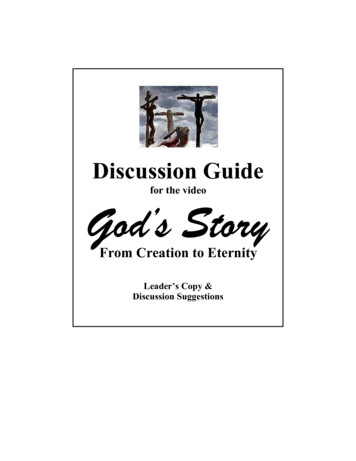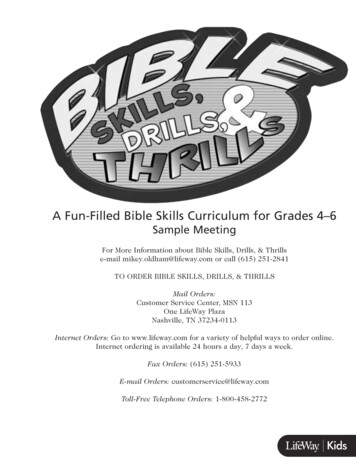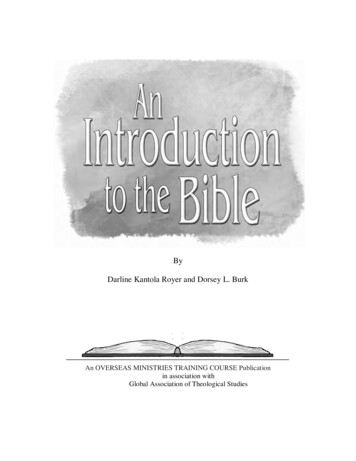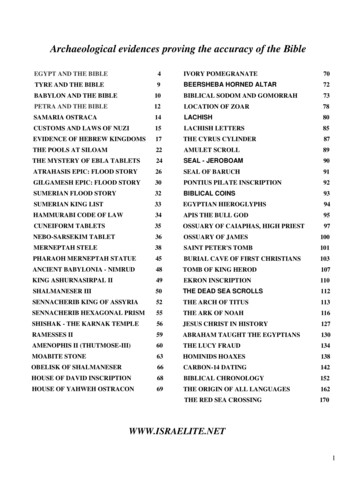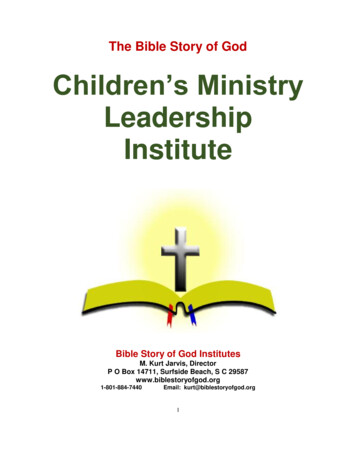
Transcription
The Bible Story of GodChildren’s MinistryLeadershipInstituteBible Story of God InstitutesM. Kurt Jarvis, DirectorP O Box 14711, Surfside Beach, S C 29587www.biblestoryofgod.org1-801-884-7440Email: kurt@biblestoryofgod.org1
2
Bible Story of GodDoctrinal Statement1.We believe the Bible to be the inspired, the only infallible, authoritative Word of God.2.We believe that there is only one God, eternally existent in three persons: Father, Son,Holy Spirit3.We believe in the deity of our Lord Jesus Christ, in His virgin birth, in His sinless life, inHis miracles, in His vicarious and atoning death through His shed blood, in His bodilyresurrection, in His ascension to the right hand of the Father, and in His personal returnto power and glory.4.We believe that for the salvation of the lost and sinful man, regeneration by the HolySpirit is absolutely essential.5.We believe in the present ministry of the Holy Spirit by whose indwelling theChristian is enabled to live a Godly life.6.We believe in the resurrection of both the saved and the lost; they that are saved unto theresurrection of life and they that are lost unto the resurrection damnation.7.We believe in the spiritual unity of believers in Christ.BSOG Leadership InstitutesM. Kurt Jarvis, DirectorThe Bible Story of GodCopyright, 2014.Duplication and/or presentation of this course material is permitted free of charge.It is requested that credit be provided that this material is part of the Bible Story of God Institutes.For more information on use of assistance in training instructors contactM. Kurt Jarvis, P.O. Box 14711, Surfside Beach, SC 29587 or call: 801-884-7440Email: biblestoryofgod@yahoo.comIn Canada, Marion Jean GrantBox 15, Caronport, Saskatchewan S0H 0S0Email: mjgrant@sasktel.net Phone: 306-756-50703
4
BSOG Leadership InstitutesThis Bible storying and storytelling Institute has been developed for laity as well as established pastors and leaderswho desire to learn practical techniques and strategies for Bible teaching and telling. Studies remind us that 70% ofthe world population either has literacy issues or prefers learning the Bible through auditory approaches, i.e.,storytelling.This institute emphasizes not only a storytelling approach but teaching God’s Word though a chronological systemof stories that not only tells the stories of God but tells and teaches the Story of God, the Bible, so that the listenerand learner fully understands God’s story and plan for mankind.This program has been taught in three U.S. colleges and universities, as well as at Millar College of the Bible inSaskatchewan, Canada, The Bible College of Malaysia, and the Asia Pacific Nazarene Theological Seminary inaddition to dozens of world locations through mission organizations and other ministry projects.Each class is 1 ½ - 2 hours and are offered according to the host church or organization’s schedule and location.Classes can be provided individually or in one program over a full day. .Relational Training – Small Group Break-Out ApproachThis training uses two major approaches that may be different from other training formats; a tag team teachingapproach and a small group break-out hands-on application process. This is what we call “relational training,” asunlike other training formats this encourages those in the training classes opportunities to share their thinking andprocessing the course content with others “during” the training rather than reflecting or debriefing at a later time.In relational training each person in the class brings to the discussion a wealth of information, perspectives and inputfrom their own past experiences and backgrounds.You will also find in this seminar program a major reduction on media supportive technology and extensive printedmaterial. This is also intentional and in many settings advanced teaching technology is not always readily availableand one of the purposes of this training is for it to be duplicable and expandable. That means those who have takenthese classes would be very capable of serving on a training team and teaching this same content to others at alater time.In order for this to occur, this seminar cannot depend on technology or extensive printed material that could possiblyneed translation and printing or equipment that others may not have. The content must stand alone as much aspossible as a training unit that can easily be duplicated and retaught by others.Hosting a Leadership InstituteBSOG offers this institute free for use by churches, ministries and international missions. Orientation of the institutecontent by one of the BSOG instructors, if desired, is available for expenses only of the instructor to train prospectivemission teams and others. Currently there are several BSOG trainers available in the U, .S. and Canada. BSOGtrainers can also be involved in a church or mission organization mission initiatives on request and accompanyteams, also for expenses only.Kurt Jarvis, FounderLeadership Institutes5
A word about the “Small Group” processThis leadership training is structured through an interactive small group process of study. Groups should be 3-5students, then multiple groups of this structure. The total class is unlimited. Whatever the total class size, groups of3-5 are formed. In most small group activities the group, as a group, will work through the page directions and thencomplete the required written information.Group Leader: The instructors either designate a group leader or the group should designate one person of theirgroup to facilitate the group sessions. Most group sessions are 10-15 minutes. This will require that the group notwaste time. The group leader should review the session directions with the group and attempt to keep the group ontask in order to complete the assignment within the allotted time.When planning the teaching time, review each class content and set a time frame for teaching each segment. Forexample, 5, 8 or 10 minutes. Then set time allowance for the following break out small group session, again, 5, 10 or15 minutes. Then add all your times to determine where you need to extend or reduce segment times. The totalclass time should be about 1.5 hours. Where translation will be needed add another half of the time allocated forpresenting. For example, 5 minutes of teaching might require 8 minutes when translation is needed.Group Session Answers: In most instances since groups work “as a group” the descriptions or answers within eachgroup may be similar. This is quite acceptable6
Children’s Ministry Leadership1. Ministry Resources Bible2. Spiritual Formation3. Individual Characteristics & Personalities4. How Memory Works5. Bible Teaching for Mixed Ages and Abilities6. Multi-sensory Teaching7. Bible Teaching Ideas8 Intro to Chronological Bible Storying9. Bible Storytelling Techniques10. Ministry Master planning & Program Planning7
8
Session 1: CMRBThe Children’s Ministry Resource BibleThomas Nelson Publishers“Everything in the Scriptures is God’s Word. All of it is useful for teaching and helping people and forcorrecting and showing them how to live. The Scriptures remind God’s servants to do all kinds of gooddeeds.”II Timothy 3:16 CEVMinistry abounds with a variety of teaching tools. Options for curricula, supplemental teaching aids,storybooks, games, songs and other materials seem endless. New teaching tools are always beingdeveloped and existing ones revised.The essential and indispensable tool is the Bible: The Word of God.1. Ministry Resource Bible OverviewA.Getting started - The Ministry Resource Bible lesson outlines. B.Old Testament lesson listingNew Testament lesson listingp. xxxi, xxxiip. xxxiiResource Bible Teacher-Leader Helpsp. xxxiii, xxxiv2.The Ministry Resource Bible lesson outlines CMRB pp. xv-xvii3.Teaching Biblical Principles4. p.923 p.1499The Prayer Hand p.1541The Promise Hand p.1549The Growth HandSalvation handCMRB symbols: See lesson on pp. 1172-1176 how these symbols are used in lesson outlinesGroup Session: Each member of the group should study one of the object lessons listed in SectionII, Individual Training, for about three minutes. (see pp 923, 1499, 1541, 1549) Then, each personpresents the object lesson they selected to their group.5.Other CMRB Helping ArticlesA.Counseling those with Special Needs9CMRB p. 1150
B.Counseling in Large GroupsCMRB p. 1151C.Teaching Aidspp. xxxiii-xxxiv p. 107The Ark of the Covenant – (covering colors) p. 111The High Priest p. 122The Tabernacle pp. 512, 513The Temple pp. 650, 1614Creation vs. Evolution p. 914Names of God p. 1490The Armor of God p. 1482The Fruit of The SpiritD. Teacher Developmentp. xxxiii10
#2: Spiritual FormationSpiritual FormationIn any society we know that people often have a worldview or world viewpoint that conflicts with a biblicalworldview. The “world” (parents, siblings, friends, extended family, parent(s) may advocate or model lifevalues or principles that conflict with biblical teaching. Without knowledge of God’s principles or standardsthe individual may come to the story encounter with worldview concepts that are inaccurate. In order toteach a biblical worldview we must know the conflicts, misinformation or non-biblical thinking processes,which are teaching obstacles we will face.It is essential that we ask ourselves these questions in teaching the Bible and salvation?1.Foundational SkillsA.Counseling Students for salvation1.Determine why the individual responded2.Be sure the individual understands his/her need for salvation.3.Be sure the individual understands the pathway of salvation.4.Use Scripture to help the individual understand the steps of salvation.a. Everyone is born with sin“All have sinned.” Romans 3:23b. God loves us and gave His Son, Jesus, to take away our sin.“For God so loved the world .” John 3:16c. If we ask God to forgive us our sin, He will.“If we confess our sins.” I John 1:9d. When we are forgiven, we become part of God’s family.John 1:12B.Young children (ages six and younger): Children younger than seven or eight yearsold do not mentally process in abstract terms or thinking. The Wordless Book is too difficult aconcept for young children to understand and process, i.e., attaching colors to segments of God’splan of Salvation. For young children they need to be told the story of Jesus in simple terms sothat they understand the following:oooooooooGod created the world and everything in it.People are separated from God because of sinEveryone has sin in his or her life. Everyone, at some time, has disobeyed GodJesus is part of God, He is God’s SonGod sent Jesus to earth to take away our sinIf we ask Jesus to forgive our sin He will do thatIf we ask God to help us not disobey Him, God will help us be obedient to HimJesus loves us and is our friendIf we love Jesus and let Him help us to be obedient to God, He will help us11
oC.If we know and love Jesus we will be with Him in HeavenThe Wordless BookCMRB p. xxviiTeaching Salvation DemonstrationsIt is unfortunate when church teachers and workers take all the time to teach Bible stories butnever tell the most important message of God’s Word – God’s Plan of Salvation for everyindividual. Children and teens need to be intentionally and purposely taught God’s plan ofSalvation. Keeping in mind age level appropriateness of presenting God’s Plan of Salvation, thefollowing ideas may be of help: The Wordless Book: This approach was developed by Rev. Charles Spurgeon in thelate 1800’s and has been heavily used by Individual Evangelism Fellowship and otherStudents ’s ministry organizations. Use the Wordless Book color-coded approach as aguide for remembering the key points in God’s Plan of Salvation. The colors can be madeinto construction paper booklets or into color beaded bracelets or necklaces, or a varietyof other ways to use colors to teach this concept.oooooGold color – This color represents heaven where the “streets are paved like gold.” Itreminds us that heaven is a perfect place. This is where God lives and He desiresthat after we die that we come there and live with Him for all eternity.Dark page - a soiled page or black color page can be used, but it should be calledthe “dark” page. This page reminds us that sin came into the world through thedisobedience of Adam and Eve and that everyone is born into sin. We cannot be inheaven with God when we have sin in ourselves. We cannot get rid of sin by doinggood things.Red page – This color tells us that God loved us so much that He sent His only Son,Jesus to die as a sacrifice for our sin. Jesus was the perfect Son of God and that Hewas the sacrifice on our sin.Clear page – A white page can be used for this, or a transparent film page, but eitherway this page should be called the “clear” page. This page indicates when we askGod to forgive our sin He forgives us and removes all the dark sin in our life.Green page – This page reminds us that we grow in God as we read the Word ofGod, pray and spend time with others who also believe in Christ as their Savior.Activity:In break out groups of 3-5 each person should present God’s Plan of Salvation totheir group using the color system. The Evangecube or Square Box – The Evangecube resource (www.E3Resources.com)is an excellent way to tell about God’s Plan of Salvation using pictures. This resource isonly available by purchasing but a similar tool can be made from a square box and gluingon pictures that represent the following parts of teaching Students God’s plan ofSalvation:oooSide 1: Can be a picture to depict heaven. Heaven is described as where Godlives, the one and only living God who created the world. Heaven, where Godlives, is a perfect place. There is no sin in heaven.Side 2: A picture depicting the Garden of Eden and/or Adam and Eve. Tellingchildren or tees how sin and death came into the world through the disobedienceof Adam, and Eve and from then all into all mankind. Because of sin man wasseparated from God because God is perfect. We cannot enter heaven with sin.Side 3: A picture depicting Jesus can be a baby, nativity scene, etc. The12
ooostudents are told that God loved everyone so much He sent His Son, Jesus, as ababy to earth to live and then top die for the sin of all mankind.Side 4: Can be a picture that denotes cleanliness. This could be a heart that iswhite or just a white side. Students are told that we can only become clean insidefrom our sin when we ask Jesus to forgive us and when we do ask God toforgive us, all our sin is forgiven and our spirit or soul is then clean. The Bible tellsus if we ask God to forgive us and tell Him we are sorry for our sin that He doesand will forgive us.Side 5: Second picture of heaven. God tells us that once we are forgiven of oursin, that after we die we have His promise that we will be with Him in heaven. Ifour sin is not forgiven we are separated from God forever and placed in hell, aplace for those who have not become part of God’s family.Side 6: Picture depicting things that grows. Students are told that once webecome part of God’s family by having our sin forgiven that we need to grow inwhat we know about God and others who are Christians too. We grow bylistening to His Word, reading the Bible, being with other Christians, praying andliving each day to help others know Him too.Activity:Making a Salvation cube or box. Using a square box class members can make aSalvation cube with colors, symbols or pictures. Pictures or symbols can be drawn on plain paper,cut to size and attached to the cube sides.Activity:In break out groups of 3-6 group members should present God’s Plan ofSalvation to their group using a picture cube.13
Session 3: Student’s Characteristics & PersonalitiesAges 4-5PhysicalMentalSocialSpiritualHints for teachingEnergeticAsks “why,and how “Self-centeredEasily ledGive simpleshort answersWants to dofor selfLikes rhymesLikes gamesCan be taughtto prayCannot use smallmuscles wellTalks constantly Enjoys storiesLearning toshareCan thank GodNeeds activitychange every5-10 minutesPoor fingercontrolDesires topleaseCan believein JesusEncourage groupplayCan memorizeshort versesHas literal mindUnderstandsLikes to --------------Ages 6-8Likes to runLearning to read Likes Students Knows rightPlan activitiesjump & playown agefrom wrongwith movementAges 9-11Wants programvarietyVery literallymindedWants adultapprovalTrusts peopleVary programactivities every10-15 minutesWants to helpCan memorizewords easilyHas a best friend Likes actionstoriesPhysicalMentalSocialSpiritualWants to goplacesInquisitiveLikes to berecognized bypeersCan understand Teach to look atbasic doctrinethe Bible forlife answersActive, likesadventureExcellentmemoryEnjoyscompetitionHas heroesEncourage highstandardsNot too tidyCollects thingsVery loyalAsks aboutChristianityPresent God’sPlan of SalvationBecomingIndependentEnjoys jokesand tricksInterested infairnessInterested inpeopleEmbarrasseasilyHave sense ofhumorTeacher is VIPSincere & serious Encourage groupactivitiesGirls matureCan be moodyfaster than boysBeginning tobe attractedto opposite sexNeeds guidance Use their talentsfor ministry toothersFatigue followshigh energyLooks up toolder teensNeeds to beChallenge forinvolved inexample settingChristian serviceUse real lifestories tospiritually challengeHints for teachingChallenge -------TeensAwkward inHave keenWants to beAsks why, where, Help buildgrowthmindsaccepted bywhat and howpositive selfpeersimageOverreactsemotionally14
The Four Basic Personality StylesA. The Leader - The ProducerIs daring and unafraid in new situations.Likes to be a leader. Often tells others how to do things.Ready to take on any kind of challenge.Is firm and serious about what is expected.Makes decisions quickly.B. The Perfectionist - The PlannerIs neat and tidy and notices little details.Sticks with something until it is done.Asks lots of questions.Likes things done the same way.Tells things just the way they are.C. The Peacemaker - The PeacekeeperAlways loyal and faithful to friends.Listens carefully to others.Likes to help others.Feels sad when others are hurting.Is a peacemaker. Doesn’t like it when others argue.Patient and willing to wait.D. The Fun Lover - The PromoterTalks a lot and tells wild stories.Likes to do all kinds of fun things.Enjoy being in groups.Likes to perform.Full of energy and always eager to play.Always happy and sees the good part of everything.Activity:Age level characteristics, personalities and observing and notingeffective approachesGirl - Teen:This girl comes from a family of five siblings. She is the youngest. She is extremely shyand quiet. She never volunteers to be a classroom helper or to answer any questions. She never createsany classroom problems but doesn’t seem to have many friends because she is so shy.What strategies and ideas could help nurture this student? Consider things that could be plannedfor her for the pre-session, during class or as follow up activities:Boy - 4 Years Old:This boy is extremely active for his age. He is very loud and has very little selfcontrol. He often touches or plays with classroom materials that he has been told many times not to touch.He does not follow teacher directions very well. He often bothers other students.What strategies and ideas that could help nurture this student. Consider things that could be planned forhim for the pre-session, during class or as follow up activities:15
Working with Students of different age levels and personalitiesBuild positive relationship with each student - ask questions1.2.3.Ask questions that will NOT provide for a “yes” or “no” answerAsk Students about themselves, their friends their family, their interestsProvide students with some sort of task to help during the class.Connect with students outside the classroom setting1. If possible, once a month make contact with each individual always with parent knowledge andnever with an individual alone.2. Remember their birthday or other special eventMake the learning environment a pleasant place to be (room decorations)1. Note what your teaching area looks like. Is it an exciting place where students want to be?2. Be creative with your teaching area.Activity: What could be done in the room this course is being held?Insure that each individual feels safe in the learning setting1. For young Students , have a plan and procedure to ease students away from their parents2. Prepare for new students and visitors to make them feel specialEstablish consistent guidelines for behavior (no more than 5 rules)1. Have rules, but make them few and simple.2. Talk softer when teaching and leading3. Discover techniques to get the group’s attentiona. Raised handsb. Use motion songs to transition between activities4. Make sure Students know what you expectGroup Control1. Have helpers or assistants sit in the midst of the group or class and not on the sides.2. Never ask an individual “Would you like to do . (One thing)? Give them a choice – it solvesproblems.3. If an individual is presenting a problem, try not to embarrass them in front of the class.4. With constant problem students, have another adult take them outside the classroom, talk withthem and pray with them about their problem or behavior.1. Consider using special cues to help students know they are losing control.Turn Around Idea Bank Time out16
Soft voiceMusicIncentives / rewards / tokensSecret codeMove and separateInclude parentsRecognize positive behavior1. Even the most disruptive individual will do something right some time. Catch problem Studentsdoing things and praise them,2. Consider special cards or tokens that can be given for positive behavior that students can turn infor special gift items.Set limits and follow through1. Whatever your rules, always, always, always follow through on the2. Post your in the classroom.3. Review rules occasionally with the entire class.Adequately prepare as the teacher1. If you have not prepared your lesson well, you will have discipline problems2. Include activities in your lesson that make learning exiting and interesting.3. Develop Bible learning interactive activities.Activity: ZONK - Bible learning game17
Session 4: How Memory WorksDo you remember what you had for breakfast this morning? If the image of a big plate of friedeggs and bacon popped into your mind, you didn't dredge it up from some out-of-the-way neuralalleyway. Instead, that memory was the result of an incredibly complex constructive power -- onethat each of us possesses -- that reassembled disparate memory impressions from a web-likepattern of cells scattered throughout the brain. Your "memory" is really made up of a group ofsystems that each plays a different role in creating, storing, and recalling your memories. Whenthe brain processes information normally, all of these different systems work together perfectly toprovide cohesive thought.What seems to be a single memory is actually a complex construction. If you think of an object -say, a pen -- your brain retrieves the object's name, its shape, its function, the sound when itscratches across the page. Each part of the memory of what a "pen" is comes from a differentregion of the brain. The entire image of "pen" is actively reconstructed by the brain from manydifferent areas. Neurologists are only beginning to understand how the parts are reassembled intoa coherent whole.If you're riding a bike, the memory of how to operate the bike comes from one set of brain cells;the memory of how to get from here to the end of the block comes from another; the memory ofbiking safety rules from another; and that nervous feeling you get when a car veers dangerouslyclose, from still another. Yet you're never aware of these separate mental experiences, nor thatare they coming from all different parts of your brain, because they all work together so well. Infact, experts tell us there is no firm distinction between how you remember and how you think.This doesn't mean that scientists have figured out exactly how the system works. They still don'tfully understand exactly how you remember or what occurs during recall. The search for how thebrain organizes memories and where those memories are acquired and stored has been a neverending quest among brain researchers for decades. Still, there is enough information to makesome educated guesses. The process of memory begins with encoding, and then proceeds tostorage and, eventually, retrieval.2.How People Learn & Bible MemoryWhat studies tell us about how we remember.?3.1. % of what we readVerbal receiving2.% of what we hearVerbal receiving3.% of what we seeVisual receiving4.% of what we hear and seeVerbal & visual receiving5.% of what we saye.g.: Teaching a lesson/sermon6.% of what we say and doThe real thing!How memory can be improved:F.Over learning – word perfectG.Distributed practice * (practice and review over several days vs. cramming)H.When words are understandable *18
I.Concrete vs. abstractJ.Main idea over detailsK.Effective recall systems *L.Multi-sensory learning systemsBible Verses for Students“Jesus said, I am the way, the truth and the life ”Abstract or Concrete?“In the beginning God made the heavens and the earth ”Abstract or Concrete?A Bible Memory Program That WorksSource: Daryl Dale, Spiritual Formation MinistriesRev. Daryl Dale of Spiritual Formation Ministries conducted research and demonstrated that in spite ofvaliant effort on the part of teachers and leaders, that few students retain more than 5 or 6 Bible verses bymemory into adolescent years. Further, most adults fare no better than this record and most of the versesthey know by memory were learned as an individual.Rev. Dale has proposed and there is current study to indicate significant success in his Bible memoryapproach. If students are given fewer verses to learn each year and in his Bible memory verse programincludes regular ongoing review of previous verses learned, by the time an individual completes 6th gradehe or she will have committed 56 verses to memory for life.Rev. Dale’s system begins at age 4 with only four verses, appropriate to Students that age, with only fourmore added during age 5 or kindergarten. Each quarter all previous quarter verses are reviewed as wellas the new verse for the quarter added. From first through 6th grade students are then only given eightadditional verses each year, always with review of previous verses learned.By sixth grade students in this Bible memory program have fully master memorization of 56 verses.Rev. Dale suggests that verses are selected which support and reinforce the 12 areas of spiritualdevelopment for Students ; Bible knowledge, worship, Salvation, missions, church life, devotional life,prayer, Christian service, outreach, missions, Bible memory, stewardship.When teaching memory verses, be sure to select verses that have the desired meaning to teach theintended biblical principle or truth. For unsaved students, use verses that clearly explain God’s Plan ofSalvation and then use the Bible memory activity to teach this to the students as they learn the verse.Ages 3&4Age 5Age 6Age 7Age 8Age 9Age 108 newversesReview 40verses8 newversesReview 32verses19Ages11&128 newversesReview 48verses
8 newversesReview 24verses8 newversesReview 16verses8 newversesReview 8verses4 newversesReview 4verses4 newversesBible Memorization Activities: Walk the Verse: Make a template of a large footprint out of construction paper then makeseveral copies. Write one word of the verse on each footprint and place these in a circle. Usea small piece of rolled masking tape to stick the footprint to the floor or carpet. Have thestudents “walk the verse” repeating each word as they walk the Bible verse circle.Bible Memory in Color: Call on students to say the verse by an article of clothing color.Example, “Someone who is wearing anything with red can say the verse.” Bible Verse Scramble: Place the words of the verse on various construction paperrectangles. Place these face down. On signal, have the player or players turn all cards overand put the verse in the correct order. Clothesline Bible Verse Scramble: Place each word of the verse on a piece of index stockpaper cut to the shape of clothing articles. Stretch a rope or have two students hold the ropeand using spring clothespins, attach the verse in scrambled order on the line. On the signalhave the player or team unscramble the verse. All in a Line Bible Verse Scramble: Have the number of students stand in a line, as thereare words in the verse. Give each individual one card to hold that has one word of the verseprinted on with the words facing towards them On signal have the Students turn the cardsaround and have the player or team move the cards to put the verse in the correct order. Sound Effects Bible Verse: Have Students develop a sound effect for each word in theverse. Use drums, tambourines, whistles, a small horn, etc. Have students play one soundeffect for each word. Prerecorded sound effects can also be used that might include crashingsounds, thunder, etc.20
Session 5: Creative Bible Teaching for Mixed Agesand AbilitiesIn ministry we often have students with a wide range of skills and abilities. To be effective we mustlearn how to address the needs of each of these students. Some students will be below level, some atlevel, and others above level in your programs. It is imperative that we identify each individual'sstrengths and weaknesses so that we can adapt our teaching style and plan programs and lessons tobest serve the unique needs of each student. This can be a di
The essential and indispensable tool is the Bible: The Word of God. 1. Ministry Resource Bible Overview A. Getting started - The Ministry Resource Bible lesson outlines. Old Testament lesson listing p. xxxi, xxxii New Testament lesson listing p. xxxii B. Resource Bible Teacher-Leader Helps p. xxxiii, xxxiv 2.





